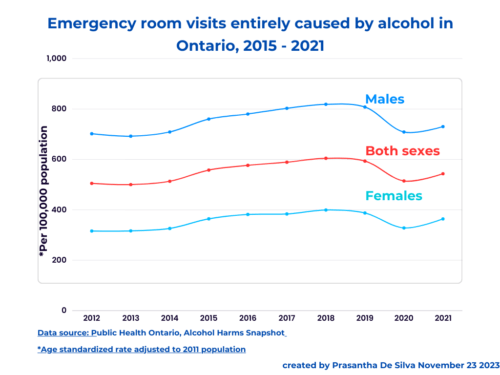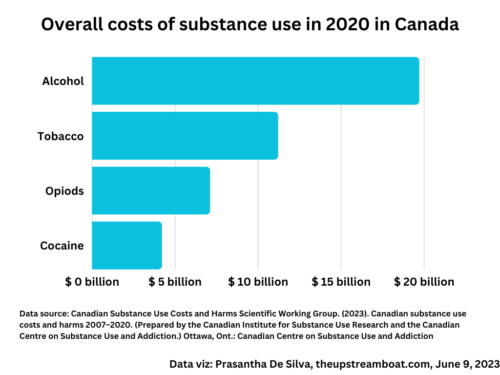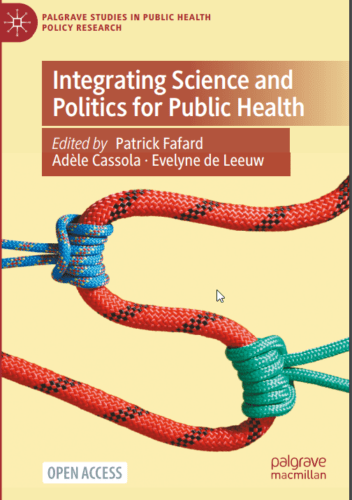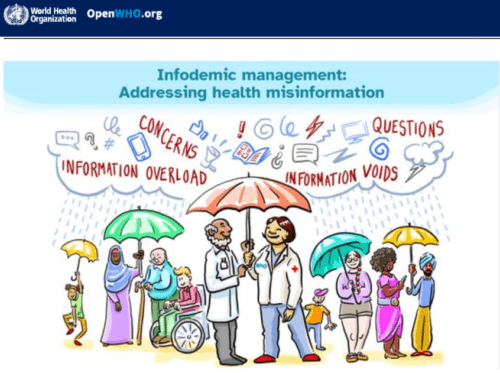Updated on March 12, 2023
The above image is a road safety nudge. The road arrows guide road users into two choices; either go straight or turn. We find those nudges all the time.
The word, nudge, refers to “prodding (a gentle push) someone’s elbow to draw attention”.
This post delves into nudging to understand heuristics and cognitive biases for better decision-making in the health sector.
A brief history of the “nudge” theory
The nudge theory’s roots date back to the early 1970s. That was when cognitive and social psychology research started to gain traction. It began with the influential research paper published by Amos Tversky and Daniel Kahneman in 1972 and 1974:"Judgement under uncertainty:Heuristics and Biases".
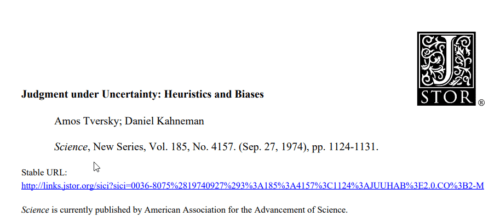
Since then, many research giants have made enormous contributions to this field. The leading figures are Richard Thaler, Cass Sunstein, Robert Cialdini, and Dan Ariely; two of them won Nobel prizes: Daniel Kahneman and Richard Thaler. And, there are many more behavioural science researchers and practitioners around the world.
The fly in the urinals and Richard Thaler

(Wikimedia Commons under the Creative Commons license CC-BY 2.0)
Richard Thaler talks about a particular case that he heard of: The fly in the urinal.
Aad Kieboom who was in charge of Amsterdam’s Schiphol Airport in the early 1990s had pasted a small picture of a house fly in urinals. His aim was to nudge men to take accurate aim and avoid urine spilling on the floor. Upon implementation, he estimated that their bathroom cleaning cost was reduced by 8 per cent.
Nudge for behaviour change has travelled a long long way since 2008. It gained momentum with the publication of Richard Thaler and Cass Sunstein’s book, “Nudge” in 2008.
By 2010, David Cameron’s UK government opened a “Nudge Unit”. After that, many powerful governments such as the US, Germany, France, Australia, The Netherlands, New Zealand, and Singapore have so far established such units. Many more are now joining the fray. It is simply because Nudge interventions save millions of taxpayers’ money without investing anything substantial.
(The following image is a #commissionearned link from the Amazon Associate program; therefore, if you buy through this link, I earn a commission from qualifying purchases at zero additional cost to you.)

Nudge builds upon the concept of heuristics.
What are heuristics?
Are we rational in our day-to-day decision-making? Nope, particularly when we face uncertainties. In those situations, we use heuristics; heuristics are “mental shortcuts”. It saves time and helps us to make quick decisions without much thinking. However, these same heuristics can lead us to make erroneous decisions with serious consequences also.
Heuristics are useful;
Amos Tversky and Daniel Kahneman 1974
Main types of heuristics
In the 1974 seminal paper, Amos Tversky and Daniel Kahneman explain three main types of heuristics:
- Availability heuristic,
- Representativeness heuristic,
- Anchoring and adjustment heuristic
Availability heuristic
The availability heuristic refers to situations when we make our decisions based on what is readily available to our minds.
This can occur in three ways;
- Easily retrievable memory or readily available knowledge at hand
For example, we might think COVID-19 is not serious if we know someone who became test positive recently but was not hospitalized; however, the opposite is also true. It also depends on how frequently the media reports on what.
Another example is that when the media frequently reports child abuse incidents we tend to think these events are rising; in reality, it may not be the case. On the other hand, when such a degree of reporting does not occur, we might think such events are rare.
Marketers and politicians often use this tool to their advantage.
“A reliable way to make people believe is frequent repitition”.
Daniel Kahneman,”Thinking Fast and Slow” 2011
This also goes hand-in-hand with the “affect heuristic” – the risk perception becomes greater when reporting is rooted in fear.
This applies to both good and bad alike.
- Imaginability:
In situations when we do not have any memories to gauge the probability of occurring an event, we depend on our imaginability. If we can recollect the difficulties of each step of a task vividly we tend to think the task is too risky; conversely, we might underestimate the risk if we cannot conceive or recall the difficulties we faced earlier.
Similarly, we tend to think it is happening more frequently if we can imagine how to carry out a task very easily.
If we can do a task very easily and think its steps vividly, we tend to think everyone else are doing it.
- illusory correlation:
“Illusory correlation refers to the appearance of a relationship that in reality does not exist”
APA Dictionary of Phychology
In this situation, we think two events carry a causal relationship although, in reality, no such thing exists. For example, a sports fan might believe wearing a red colour shirt helps to win a game. A much-researched topic is an illusory correlation between undocumented immigrants and terrorism. Furthermore, research has demonstrated majority commonly exhibit an illusory correlation between undesirable behaviours and minority groups. These situations lead to prejudice and discrimination of minority groups by the majority.
Representativeness heuristic
A classic example of this type of heuristic is the young people’s judgment of their lower risk of contracting the COVID-19 virus. It is because of the early perception that they do not represent the typical “prototype”: Old and those with pre-existing illnesses. This was what mainstream media and health professionals projected at the beginning.
The chance of occurring an event depends on the degree to which,
- It is similar to essential features of the parent population,
- It reflects the salient features of the process by which it is generated.
(Daniel Kahneman and Amos Tversky, 1972)
Anchoring and adjustment heuristic
We tend to make decisions using readily available information or value at the beginning as the anchor. It is difficult to change later.
Different starting points yield different values is called anchoring.
Amos Tversky and Daniel Kahneman, 1974
The danger here is that we will find it difficult to change our judgment when the initial value or information changes later.
It is like this; think of a situation where you are going to buy a car. Although you may have an estimate of the value before meeting the seller, the seller’s asking price often acts as an anchor. If the seller begins with a higher price tag you tend to settle for a price next lower to the value; on the other hand, if the seller sets a lower price than the previous one, you are likely to settle for a value next closer that anchoring value. However, the seller will find it difficult to set a higher value later.
This happened during the COVID-19 pandemic.
In March 2020, the US sURGEON-Geeral incorrectly asserted masks are ineffective; the later change following evidence became difficult for the US population to absorb (A.A. Madison et al. 2021).
Power of heuristics
Heuristics are very powerful;
The reliance on heuristics are not restricted to laymen; even experienced researchers can fall prey.
Amos Tversky and Daniel Kahneman, 1974
In summary,
Humans make errors in remembering, deciding, and predicting because they use mental shortcuts.
David Halpern; “Inside the Nudge Unit”, 2015
And, its prevalence is so common and powerful; that we all often fall prey to it.
The good thing here is that these mental shortcuts are not random. That means anyone can predict. As a result, we can use these shortcuts to develop powerful behavioural interventions; this is where nudging steps into.
Nudge tools
Several nudge tools exist. The MINDSPACE is the first comprehensive framework that describes strategies to address different aspects of heuristics. It was introduced in 2010 by a UK team.
Another excellent one is the E.A.S.T. It is a simplified version of MINDSPACE. David Halpern introduces nudge strategies using E.A.S.T. mnemonic using compelling real-life examples in his 2015 memoir: “Inside the Nudge Unit”.
The E.A.S.T.
David Halpern introduces this simplified version – E.A.S.T. – of the 2010 MINDSPACE framework in his exemplary 2015 memoir, “Inside the Nudge Unit”. On page 60, he says the E.A.S.T. is a mental heuristic and useful for day-to-day use. He also mentions that “like all heuristics”, it will miss some angles and nuances of behavioural insights.
The E.AS.T. refer to;
- E: make it easy or make it difficult
- A: make it attractive
- S: make it social
- T: make it timely
Let us see how this works;
E: Make it easy or make it difficult
We can nudge by making the action or behaviour easier to perform than at present, or else we can nudge not to take action by making the current action harder to perform.
How?
- Change the default action: David Halpern mentions a very impressive and powerful example of this simple nudge – to get employees for pension plans, the government changed its default action from opt-in to opt-out. Earlier, employees had to complete a form and give their consent to opt-in for a pension plan; that was the default action. the new default action was that the employees were automatically entitled to a pension plan. If they want to opt-out, they needed to fill out a form. The result: By early 2015, more than 5 million UK employees enrolled on a pension plan.
- Make it simple – want to eat fruit? make it more available and accessible in the marketplace and even at home, pre-filling forms for uni. entrance, filing tax forms, removing paperwork,
- Or, make it difficult: putting a bump on the road, cigarettes can only be sold over the counter, to reduce suicides due to pesticides, one strong recommendation is to keep pesticides locked.
A: Attract
Below is another road nudge. It attracts the user to choose one from the choice structure presented.

Other road nudges we come across are;
- Speed signs
- Slow-down signs
- Warning signs
- Speed bumps
- displaying your speed
- visible police traffic cars on the road
Some common nudges that employ attract method are;
- Use attractive colours – Supermarkets keep contrasting colours – red and green; blue and yellow – side by side. Not only the colours, but supermarkets also use soothing music, smell, and appearance to attract customers.
- Use images of beautiful sceneries alongside staircases to promote its use
- Use of attractive speed signs, flashlights, bright yellow reflective materials around corners, speed feedback signs
- Use of strong deep-rooted emotional drivers such as honour, shock, disgust, curiosity, humour, and fun
3. S: Social
- Use social norms to persuade others: Tell what most others are doing when the targeted behaviour is healthy; on the other hand, when a minority is carrying out a healthy behaviour, highlight what most others think is most suitable to do.
- use reciprocity
4. T: Timely
- Intervene before the behaviour is getting established.
- Intervene where and when the behaviour is about to occur: e.g. adding warning labels on alcohol bottles, and cigarette packs, at the time of purchase of anything,
- Intervene to help (get them into a social commitment/contract) what their future self want to do, not the present self; our decision-making for the same problem differs with the time what we are going to do: E.g. when we were offered healthy food vs unhealthy food and the choice to be done tomorrow, we would choose healthy food; in contrast, if we were asked to make the choice now, we tend to choose unhealthy food). the same holds for quitting smoking also. to address this, get them into a commitment contract.
